
Welcome to Hyperion Records, a British classical label devoted to presenting high-quality recordings of music of all styles and from all periods from the twelfth century to the twenty-first.
Hyperion offers both CDs, and downloads in a number of formats. The site is also available in several languages.
Please use the dropdown buttons to set your preferred options, or use the checkbox to accept the defaults.

La Leggierezza (‘Lightness’) also begins a capriccio, but quickly finds its main material in a very simple single line in each hand, and the unusual tempo direction ‘Quasi allegretto’ (which is almost always ignored in performance in favour of something more frenetic). Like the other pieces in this set, it is monothematic, but the contours of the original theme must be sensed more than observed under the delicate decoration with which it is subsequently varied. Liszt’s quiet ending did not seem sufficiently applause-gathering to the great Polish pedagogue (but very minor composer) Theodor Leschetizky (1830–1915). He embellished the piece with a new coda which used to be regularly adopted in concert. With best respects, the present writer prefers not to be a hostage to those that already find Liszt vulgar (and how this conclusion is reached specifically for Liszt without embracing many another prolific Renaissance man—Haydn, for example?—is itself a conundrum, although Liszt’s music has frequently been performed vulgarly enough), and Liszt’s gentle Picardie cadence is retained here.
Un Sospiro (‘A sigh’) is the best known of the set, and was much taught by Liszt in his later years. The felicity with which, in a single work, Liszt took the speciality of Sigismund Thalberg (1812–1871)—the technical sleight of hand whereby a melody is surrounded or supported by arpeggios such that an impression of three hands at the keyboard is given—and ennobled it once and for always with one of his finest melodic inspirations has kept this piece in demand from the beginning. (For the benefit of anyone who has not seen this piece performed, it should be mentioned that the melody notes are taken by left and right hand in turn whilst both hands maintain the flowing accompaniment.) In his masterclasses Liszt took to adding a cadenza at the fermata before the return of the theme in the home key—where it is ever more cleverly divided between the thumbs whilst the accompaniment manages to travel far and wide in both hands. The cadenza that he wrote for Auguste Rennebaum in 1875 is included at this point, but, because it would be a pity not to have them, the cadenzas that he wrote for Henrik Gobbi (date unknown) and for Lina Schmalhausen (1885) are included by way of an optional preamble. Lina Ramann preserved Liszt’s late alternative coda in the Liszt-Pädagogium, and this text is adopted here. Liszt at once preserves the mediant progressions of the transition sections of the etude in the ascending right hand whilst introducing a descending whole-tone scale in the left.
from notes by Leslie Howard © 1996
La Leggierezza («Légèreté») débute également a capriccio mais trouve rapidement son matériau principal dans une seule ligne, très simple, dans chaque main, mais aussi dans l’insolite direction de tempo «Quasi allegretto» (presque toujours ignorée des interprètes au profit de quelque chose de plus frénétique). Comme les autres morceaux de cet ensemble, cette pièce est monothématique, mais les contours du thème original doivent être pressentis, davantage qu’observés, sous la décoration délicate qui intervient ensuite. Le final paisible de Liszt ne parut pas suffisamment générateur d’applaudissements aux yeux du grand pédagogue polonais (mais compositeur très mineur) Theodor Leschetizky (1830–1915), qui orna le morceau d’une nouvelle coda, régulièrement adoptée en concert. Malgré tout son respect, l’interprète préfère ne pas être le jouet de ceux qui jugent déjà Liszt vulgaire (le comment de ce jugement spécifiquement appliqué à Liszt, et non à quantité d’autres hommes prolifiques de la Renaissance—tel Haydn—étant en soi une énigme, même si la musique de Liszt a fréquemment été interprétée de manière assez vulgaire) et conserve la douce cadence de Picardie originelle.
Un Sospiro («Un soupir»), l’œuvre la plus célèbre des trois, fut énormément enseigné par Liszt dans ses dernières années. La félicité avec laquelle il s’appropria, en une seule pièce, la spécialité de Sigismund Thalberg (1812–1871)—savoir le tour de passe—passe technique par lequel une mélodie est entourée ou soutenue par des arpèges, comme si trois mains couraient sur le clavier—pour définitivement l’ennoblir dans une de ses plus belles inspirations mélodiques valut à cette œuvre une demande constante. (Pour ceux qui n’ont jamais vu interpréter ce morceau, précisons que les notes de la mélodie sont alternativement jouées par les mains droite et gauche tandis que les deux mains maintiennent l’accompagnement fluide.) Dans ses masterclasses, Liszt commença à ajouter une cadence au fermata avant le retour du thème dans le ton usuel—où il demeure, plus que jamais, intelligemment partagé entre les pouces pendant que l’accompagnement parvient à courir dans les deux mains. La cadence qu’il écrivit pour Auguste Rennebaum en 1875 est incluse à cet endroit. Et, parce qu’il serait dommage de ne pas les avoir, les cadences composées pour Henrik Gobbi (date inconnue) et Lina Schmalhausen (1885) sont proposées sous forme de préambule optionnel. Dans le Liszt Pädagogium, Lina Ramann conserva la dernière coda de Liszt, établissant le texte adopté ici. Liszt réussit à préserver les progressions médiantes des sections transitoires de l’étude dans la main droite ascendante tout en introduisant une gamme par tons entiers descendante dans la main gauche.
extrait des notes rédigées par Leslie Howard © 1996
Français: Hypérion
La Leggierezza („Leichtigkeit“) beginnt ebenfalls als ein Capriccio, findet jedoch schnell sein Hauptmaterial in einer sehr einfachen Zeile für jede Hand und trägt die ungewöhnliche Tempo-Anweisung „Quasi allegretto“ (die in Konzerten fast immer zu Gunsten etwas eher frenetischem ignoriert wird). Wie die anderen Stücke in diesem Satz ist es monothematisch, jedoch müssen die Konturen der ursprünglichen Melodie unter der zarten Dekoration, mit der sie später variiert wird, eher gefühlt als observiert werden. Liszts stiller Abschluß schien dem berühmten polnischen Schulmeister (aber wesentlich unbedeutenderem Komponisten) Theodor Leschetizky (1830–1915) nicht in ausreichendem Maße applauserntend gewesen zu sein. Er versah das Stück mit einer neuen Koda, die bei Konzerten damals regelmäßig übernommen wurde. Mit allem Respekt hat der Verfasser nicht die Absicht, Geisel jener zu werden, denen Liszt ohnehin schon vulgär erscheint (und wie diese Folgerung im besonderen auf Liszt bezogen werden kann, ohne viele andere sehr produktive Männer der Renaissance—Haydn zum Beispiel?—einzubeziehen, stellt schon in sich ein Rätsel dar, obwohl Liszts Musik häufig vulgär genug vorgetragen worden ist), und Liszts sanfte Pikardische Kadenz wird hier beibehalten.
Un Sospiro („Ein Seufzer“) ist das bekannteste Werk dieser Reihe, und wurde von Liszt in seinen späteren Jahren oft gelehrt. Die Glückseligkeit mit der Liszt in einem einzigen Werk die Spezialisierung von Sigismund Thalberg (1812–1871) übernahm—die technische Fingerfertigkeit, durch die die Musik mit Arpaggios umgeben oder unterstützt wird, sodaß der Eindruck dreier Hände auf der Tastatur entsteht—und es ein für alle mal mit einer seiner feinsten melodischen Inspirationen adelte, haben die Forderung nach diesem Stück von Anfang an nie verblassen lassen. (Für denjenigen, dem dieses Stück noch nicht direkt vorgespielt wurde, soll hier bemerkt werden, daß die Noten der Melodie von der linken und rechten Hand abwechselnd gespielt werden, während beide Hände die fließende Begleitung aufrechterhalten.) In seinen Meisterklassen fügte Liszt der Fermate vor der Rückkehr der Melodie zur Haupttonart—wo sie auf immer glänzendere Art zwischen den Daumen aufgeteilt wird, während die Begleitung umfangreiche Ausschweifungen beider Hände bewältigt, eine Kadenz hinzu. Die Kadenz, die er für Auguste Rennebaum 1875 schrieb, ist nun hier eingeschlossen, aber, denn es wäre eine Sünde, sie nicht zu haben, die Kadenzen, die er für Henrik Gobbi (Datum unbekannt) und Lina Schmalhausen (1885) schrieb, werden durch eine fakultative Präambel eingeschlossen. Lina Ramann bewahrte Liszts späte alternative Koda im Liszt-Pädagogium, und diese ist hier übernommen worden. Liszt erhält die medianten Progressionen der Durchgangspassagen der etude in der aufsteigenden rechten Hand aufrecht und stellt gleichzeitig einen absteigende Ganztonleiter der linken vor.
aus dem Begleittext von Leslie Howard © 1996
Deutsch: Hypérion
 Liszt: Complete Piano Music Liszt: Complete Piano MusicLeslie Howard’s recordings of Liszt’s complete piano music, on 99 CDs, is one of the monumental achievements in the history of recorded music. Remarkable as much for its musicological research and scholarly rigour as for Howard’s Herculean piano p ...» More |
 Frederic Lamond - The complete Liszt recordings, HMV/Electrola 1919-36 Frederic Lamond - The complete Liszt recordings, HMV/Electrola 1919-36‘I suggest you look in this particular disc for something of Lamond’s greatness’ (MusicWeb International)» More |
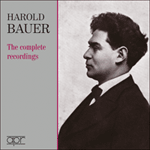 Harold Bauer - The complete recordings Harold Bauer - The complete recordings Gramophone» More Gramophone» More |
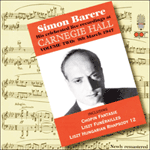 Simon Barere – His celebrated live recordings at Carnegie Hall, Vol. 2 - 9 March 1947 Simon Barere – His celebrated live recordings at Carnegie Hall, Vol. 2 - 9 March 1947 |
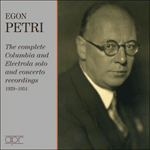 Egon Petri - The complete Columbia and Electrola solo and concerto recordings Egon Petri - The complete Columbia and Electrola solo and concerto recordingsEgon Petri (1881-1962) studied with Busoni and was perhaps his greatest disciple. In his fusion of intellect with an astonishing virtuoso technique he echoed his master and gives us today the clearest idea of Busoni’s own legendary pianism.» More |
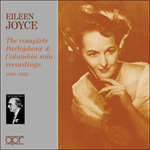 Eileen Joyce - The complete Parlophone & Columbia solo recordings Eileen Joyce - The complete Parlophone & Columbia solo recordings‘Listening to Joyce is strangely addictive. One cannot wait, as it were, to read the next chapter. She shares with Kreisler and Tauber the same unteac ... ‘The quality that comes across in these performances is the sheer joy of playing. Joyce possessed a formidable technique and an interpretative mind th ...» More |
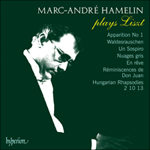 Liszt: Marc-André Hamelin plays Liszt Liszt: Marc-André Hamelin plays Liszt‘The virtuosity with which all this is despatched is exceptional’ (BBC Record Review) ‘There are few living pianists who can match him in dexterity, power and daring. For heart-thumping virtuosity Hamelin is in a class of his own’ (Clas ...» More |
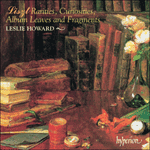 Liszt: The complete music for solo piano, Vol. 56 - Rarities, Curiosities, Album Leaves and Fragments Liszt: The complete music for solo piano, Vol. 56 - Rarities, Curiosities, Album Leaves and Fragments‘As a guide to this cornucopia Leslie Howard could hardly be bettered’ (BBC Music Magazine) ‘All kinds of fascinating morsels … there is much here to interest any admirer of this remarkable and prolific composer’ (The Penguin Guide to Co ...» More |
 Louis Kentner – The pioneering Liszt recordings, Vol. 2 Louis Kentner – The pioneering Liszt recordings, Vol. 2'Excellently transferred from 78s dating from 1939-59, this selection ranges from Liszt’s early exuberance to the grim-faced austerity of his final ye ...  BBC Music Magazine» More BBC Music Magazine» More |
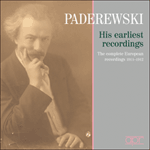 Paderewski - His earliest recordings Paderewski - His earliest recordings |
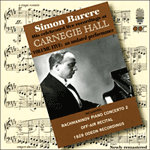 Simon Barere – His celebrated live recordings at Carnegie Hall, Vol. 5 - Rachmaninov's Piano Concerto No 2 & appendices Simon Barere – His celebrated live recordings at Carnegie Hall, Vol. 5 - Rachmaninov's Piano Concerto No 2 & appendices'The fifth and final volume of Simon Barere’s live Carnegie Hall performances includes a fascinating, typically vertiginous performance of Rachmaninov ...» More |
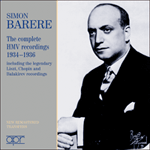 Simon Barere - The complete HMV recordings 1934–1936 Simon Barere - The complete HMV recordings 1934–1936 |
 Liszt: Piano Music Liszt: Piano Music |

